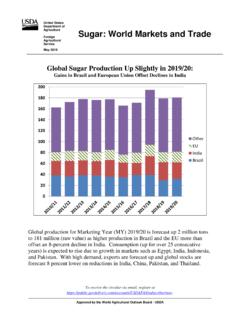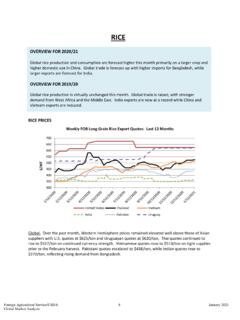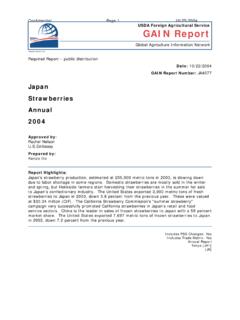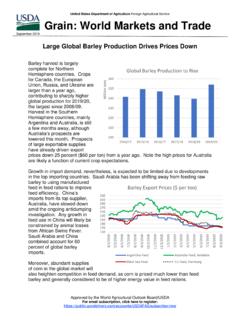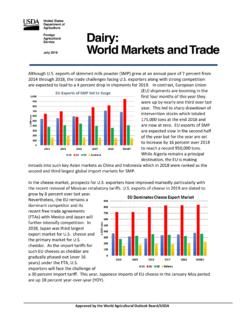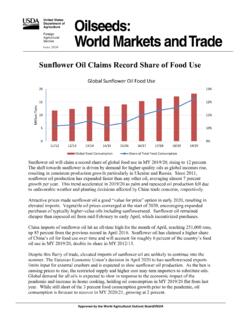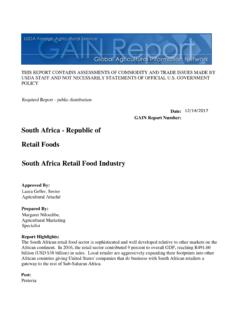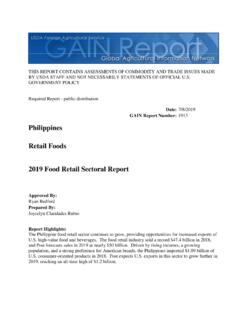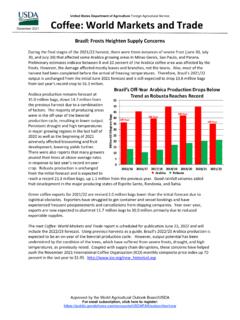Transcription of Japan Food and Agricultural Import Regulations and …
1 THIS REPORT CONTAINS ASSESSMENTS OF COMMODITY AND TRADE ISSUES MADE BY USDA STAFF AND NOT NECESSARILY STATEMENTS OF OFFICIAL GOVERNMENT POLICY Required Report - public distribution Date: 12/21/2018 GAIN Report Number: JA8113 Japan Food and Agricultural Import Regulations and Standards Report 2018 FAIRS Annual Country Report Approved By: Christopher Riker Prepared By: Japan staff Report Highlights: This report is an overview and update of Japan s general legal and technical requirements for food and Agricultural imports.
2 Food and Agricultural suppliers to Japan are recommended to consult with local importers and appropriate regulatory agencies for the most current local requirements prior to shipping. For more information on Japan s certificate requirements , see FAS/ Japan s Food and Agricultural Import Regulations and Standards 2018 FAIRS Export Certificate Report at NOTE: This report was prepared by the Office of Agricultural Affairs of the USDA/Foreign Agricultural Service at the Embassy/Tokyo for exporters of Agricultural products. While great care was taken in the preparation of this report, the information provided may not be completely accurate due to either changes in policies since its preparation, or because clear and consistent information about these policies was not available at the time of publication.
3 It is highly recommended that exporters verify the relevant Import requirements with their foreign customers, who normally have the most updated information on local requirements and can research such matters with local authorities, prior to exportation. FINAL Import APPROVAL OF ANY PRODUCT IS SUBJECT TO THE IMPORTING COUNTRY S RULES AND Regulations AS INTERPRETED BY BORDER OFFICIALS AT THE TIME OF PRODUCT ENTRY. Contents Report Highlights: .. Error! Bookmark not defined. Section I. General Food Laws .. 3 Section II. Food Additives Regulations .. 4 Section III. Pesticides and Other Contaminants .. 6 Section IV. Packaging and Container Regulations .. 9 Section V.
4 Labeling 10 Mandatory Processed Food Labeling .. 10 Mandatory Fresh Food Labeling .. 11 Food Additives .. 11 Biotech Labeling requirements .. 11 Country of Origin Labeling (COOL) for Certain Ingredients .. 11 Alcoholic Beverage Labeling .. 12 Animal Products .. 12 Voluntary Nutritional Labeling and Nutrition Claims .. 12 Misleading Representations .. 14 Forthcoming Changes to Japan s Labeling requirements .. 14 Section VI. Other Specific Standards .. 15 Foods from Biotechnology .. 15 Organic Foods .. 16 fruits and vegetables and Unprocessed Grain Products .. 16 Frozen fruits and vegetables That Are Permitted Entry .. 16 Forest Products .. 17 Section VII.
5 Facility and Product Registration .. 17 Section VIII: Other Certification and Testing requirements .. 18 Section IX. Import Procedures .. 19 Section X. Copyright and/or Trademark Laws .. 21 Copyright and Trademark Laws .. 21 Protected Geographical Indications .. 22 Regional Collective Trademarks .. 22 Appendix I. Government Regulatory Agency Contacts .. 23 Appendix II Current List of Ingredients for which Country of Origin Labeling is Required .. 26 Section I. General Food Laws There are seven major laws in Japan governing food and Agricultural products including imports: 1) the Food Safety Basic Act, 2 ) the Food Sanitation Act, 3) the Health Promotion Law, 4) the Japan Agricultural Standards Law, 5), the Plant Protection Law, 6) Act on Domestic Animal Infectious Diseases Control, and 7) the Food Labeling Law.
6 The Food Safety Basic Act sets the principles for developing a food safety regime and establishes the role of the Food Safety Commission (FSC), a food-related risk assessment body. The Food Sanitation Act, under the jurisdiction of the Ministry of Health, Labor and Welfare (MHLW), a food risk management agency, aims to protect people s health by ensuring the safety and sanitation of foods and beverages. The Food Sanitation Act 1 sets specifications and standards for foods and beverages, food apparatus, food containers and packages, additives, contaminants, and agrochemical residues, and prohibits the sale and imports of foods and beverages containing harmful substances.
7 The Food Sanitation Act also sets the monitoring guidelines, plans, and inspection measures for both domestic and imported foods and beverages, and establishes penalties for failing inspections. The Health Promotion Law (Japanese only), also under the jurisdiction of MHLW, aims to improve public health by setting guidelines and implementing measures to promote people s improved health. One of the measures is promoting nutrition management, under which a 1 The Act was revised in June 2018 and MHLW enforcement of most revisions will not begin until 2020. The major revisions pertaining to imported foods that have been proposed are to require public health attestations for dairy products and some seafood ( , puffer fish and fresh consumption oyster) and Hazard Analysis Critical Control Point (HACCP) based sanitation management for some products such as meat (see JA8103).
8 The revision also includes the introduction of a positive list system for food container and packaging materials (see JA8045). system to label Food for Special Dietary Uses is established (Prime Minister s approval is required for labeling for foods that are suitable for special dietary uses for infant, children, pregnant women, sick people, etc.). The Law concerning Standardization etc. of Agricultural and Forestry Products (JAS Law) which is administered by the Ministry of Agriculture, Forestry and Fisheries (MAFF), is a voluntary quality assurance system for foods, beverages (excluding alcohols) and forestry products. The Plant Protection Law and the Act on Domestic Animal Infectious Diseases Control are also administered by MAFF as Japan s national plant protection and animal health authority.
9 Both laws aim to prevent pests and diseases from spreading and establishing in Japan by requiring inspections for domestic and imported plants. Both also establish Import control policies. The Food Labeling Law, which is under the purview of the Consumer Affairs Agency (CAA), sets food labelling standards ( , Countries of Origin Labeling requirements , allergen labeling, expiration date labeling, foods with functional claims, etc.) as well as penalties in the event of a violation. Section II. Food Additives Regulations Food additives are regulated under the Food Sanitation Act which only permits those food additives which are assessed and designated as safe by MHLW for use in food and beverages ( , a positive list system).
10 Imported products found to contain residues from unapproved additives will not be permitted for sale. There are four categories of additives: Designated Additives, Existing Additives, Natural Flavoring Agents, and Ordinary Foods Used as Food Additives. See MHLW s website for definitions for these categories. It is important to note that an approved substance in the Designated Additives category may be limited to use on a specific product at a set level and only for a specific use. For a full list of substances approved as Designated Additives, as well as their approved uses and tolerances, please refer to the MHLW website listed above and the Japan Food Chemical Research Foundation s (JFCRF) Standards for Use of Food Additives website.

